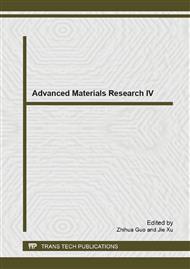[1]
W. Shockley and H. J. Queisser, J. Appl. Phys. Vol. 32 (1961), p.510.
Google Scholar
[2]
A. Nozik: Physica E Vol. 14 (2002), p.115.
Google Scholar
[3]
G. Conibeer: Materials Today Vol. 10 (2007), p.42.
Google Scholar
[4]
B. Abeles: Superlattices Microstruct. Vol. 5 (1989), p.473.
Google Scholar
[5]
A. Panchal, D. Rai, M. Mathew and C. Solanki: Nano Vol. 4 (2009), p.265.
Google Scholar
[6]
Z. Wan, R. Patterson, S. Huang, M. Green and G. Conibeer: Europhys. Lett. Vol. 95 (2011), p.67006–p.1.
Google Scholar
[7]
C. Song, R. Huang, X. Wang, Y. Guo and J. Song, Opt.: Mater. Express Vol. 3 (2013), p.664.
Google Scholar
[8]
D. Rai, N. Mavilla, A. Panchal and C. Solanki: Proc. 38th IEEE PVSC (2012), p.810.
Google Scholar
[9]
A. Panchal, D. Rai, M. Mathew and C. Solanki: J. Nanopart. Res. Vol. 13 (2011), p.2469.
Google Scholar
[10]
A. Panchal and C. Solanki: J. Cryst. Growth Vol. 311 (2009), p.2659.
Google Scholar
[11]
T. -Y. Kim, N. -M. Park, C. -J. Choi, C. Huh, C. -G. Ahn, G. Y. Sung, I. -K. You and M. Suemitsu: Jpn. J. Appl. Phys. Vol. 50 (2011), p. 04DG11–1.
Google Scholar
[12]
S. M. Sze and K. K. Ng: Physics of semiconductor devices (John Wiley & Sons, Inc., 2007).
Google Scholar
[13]
P. Alpuim, L. Goncalves, E. Marins, T. Viseu, S. Ferdov and J. Bouree: Thin Solid Films Vol. 517 (2009), p.3503.
DOI: 10.1016/j.tsf.2009.01.077
Google Scholar
[14]
A. Mahan: Sol. Energy Mater. Sol. Cells Vol. 78 (2003), p.299–327.
Google Scholar
[15]
R. Karcher, L. Ley and R. L. Johnson: Phys. Rev. B: Condens. Matter Vol. 30 (1984), p.1896.
Google Scholar
[16]
A. Ermolie_, P. Bernard, S. Marthon and J. C. da Costa: J. Appl. Phys. Vol. 60 (1986), p.3162.
Google Scholar
[17]
S. Naskar, S. D. Wolter, C. A. Bower, B. R. Stoner and J. T. Glass: Appl. Phys. Lett. Vol. 87 (2005), 261907.
Google Scholar
[18]
S. Ishidzuka, Y. Igari, T. Takaoka and I. Kusunoki: Appl. Surf. Sci. Vol. 130 (1998), p.107.
Google Scholar
[19]
H. Inao and A. Izumi: Phys. Status Solidi C Vol. 9 (2012), p.1415.
Google Scholar
[20]
O. Renner and J. Zemek: Czech. J. Phys. B Vol. 23 (1973), p.1273.
Google Scholar


